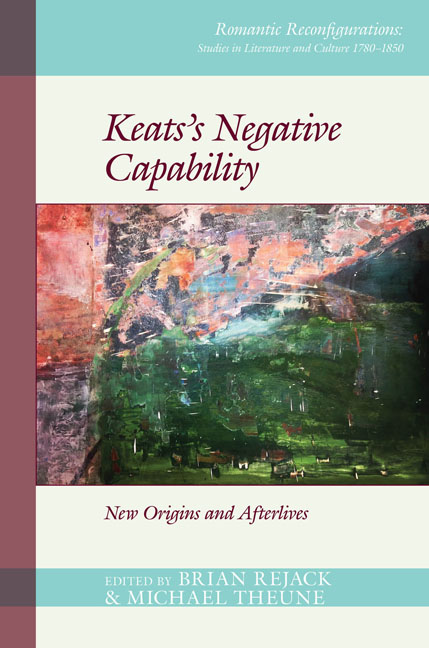Book contents
- Frontmatter
- Contents
- List of Figures
- Acknowledgments
- List of Abbreviations
- List of Contributors
- Preface
- Introduction: Disquisitions: Reading Negative Capability, 1817–2017
- Part I ‘swelling into reality’: New Contexts for Negative Capability
- Part II ‘examplified throughout’: Forms of Negatively Capable Reading
- Part III ‘pursued through Volumes’, Volume I: Negative Capability in Twentieth- and Twenty-First-Century American Poetry
- Part IV ‘pursued through Volumes’, Volume II: Adaptations, Appropriations, Mutations
- Afterword: Reading Keats's Negative Capability
- Bibliography
- Index
14 - Negative Capability in Psychoanalysis: Keats and Retroactive Judgment in Bion, Freud, Lacan, and Milner
- Frontmatter
- Contents
- List of Figures
- Acknowledgments
- List of Abbreviations
- List of Contributors
- Preface
- Introduction: Disquisitions: Reading Negative Capability, 1817–2017
- Part I ‘swelling into reality’: New Contexts for Negative Capability
- Part II ‘examplified throughout’: Forms of Negatively Capable Reading
- Part III ‘pursued through Volumes’, Volume I: Negative Capability in Twentieth- and Twenty-First-Century American Poetry
- Part IV ‘pursued through Volumes’, Volume II: Adaptations, Appropriations, Mutations
- Afterword: Reading Keats's Negative Capability
- Bibliography
- Index
Summary
In formulating his celebrated idea of negative capability, John Keats found ‘a medium for speculative thinking and critical formulations that are now part of our vocabulary’, as Susan J. Wolfson explains. Yet what is implied by that vocabulary, and that medium, have not always been stable. We tend currently to believe, as Li Ou says, that: ‘To be negatively capable is to be open to the actual vastness and complexity of experience, and one cannot possess this openness unless one can abandon the comfortable enclosure of doctrinaire knowledge.’ But that sense of the term only became fully entrenched after about 1970, following the publication of Walter Jackson Bate's Criticism: The Major Texts, as Li notes (p. 16). And Basic Books was at the same time publishing Attention and Interpretation (1970), a book by the British psychoanalyst Wilfred Bion, which appropriated and adapted Keats's concept for the psychological disciplines. Bion transformed the concept of negative capability in lasting ways, even while literary scholars, seldom reading Bion, have tended to remain wedded to Bate's understanding of the term.
Romanticists have at times treated negative capability as a proto-psychoanalytic concept. For Joel Faflak, negative capability is at once Keats's strategy for mitigating the terrifying gender ambivalence located everywhere in his poetry and a term for the poet's engagements with the unconscious dimensions of philosophy, such that Keats's poetry ‘establish[es] a dialogue with … the radical otherness of the unconscious’ as it ‘traces the dark anthropomorphism of the subject within the theater of its other subjectivities’ to create ‘the distinctly heterogeneous and dark empiricism of the Romantic psychoanalytic scene’. Emily Rohrbach sees negative capability as Keats’s way of keeping open an ‘anticipatory sense of possibilities’ through ‘multiple figurations’, an attitude which she associates with Jacques Lacan's discussions, in Écrits, of the future anterior. Even Walter Jackson Bate—someone hardly associated with psychoanalytic literary criticism—paraphrases Keats's letter in Freudian terms. Thus we can say that Romanticists have oftentimes suspected negative capability of having a psychoanalytic dimension. Yet Keats's psychoanalytic inclinations aspire, as Faflak rightly observes, ‘beyond the Freudian ken of a therapeutic cure’ (p. 230). Adapting Keats's form of psychoanalysis interminable into the less-than-Dionysian world of late twentieth-century clinical psychoanalysis—that is, to develop negative capability as a matter of analytic technique—took Bion's audacious re-reading of Keats's familiar if enigmatic letter.
- Type
- Chapter
- Information
- Keats's Negative CapabilityNew Origins and Afterlives, pp. 216 - 231Publisher: Liverpool University PressPrint publication year: 2019



